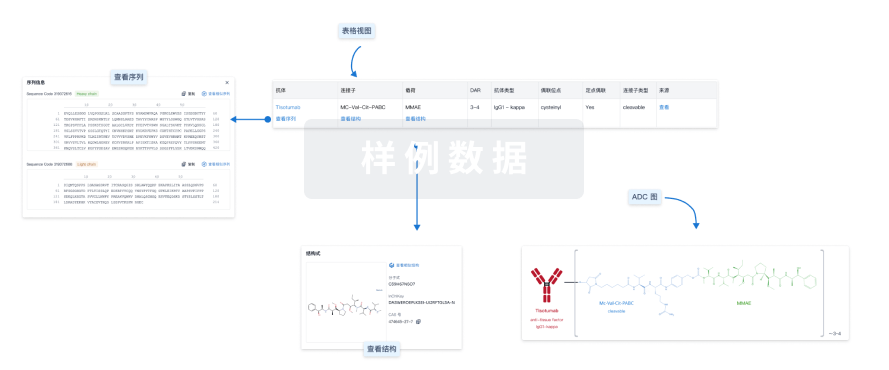预约演示
更新于:2025-11-29
STX-1
更新于:2025-11-29
概要
基本信息
非在研机构- |
权益机构- |
最高研发阶段临床前 |
首次获批日期- |
最高研发阶段(中国)- |
特殊审评- |
结构/序列
使用我们的ADC技术数据为新药研发加速。
登录
或

关联
100 项与 STX-1 相关的临床结果
登录后查看更多信息
100 项与 STX-1 相关的转化医学
登录后查看更多信息
100 项与 STX-1 相关的专利(医药)
登录后查看更多信息
148
项与 STX-1 相关的文献(医药)2025-10-01·CHEMICO-BIOLOGICAL INTERACTIONS
Shiga toxins from enterohemorrhagic Escherichia coli and anti-GB3 antibody as novel agents against triple negative breast cancer
Article
作者: Vassallu, Florencia ; Randi, Andrea S ; Miret, Noelia V ; Igaz, Lionel M ; Pinto, Alipio ; Ramos Aloi, Ana Belen ; Goldstein, Jorge
Shiga toxins (Stx) are potent bacterial exotoxins and the main virulence factor of enterohemorrhagic Escherichia coli. Stx have ribotoxic activity in eukaryotic target cells of the mammalian host by recognizing its globotriaosylceramide receptor (Gb3), which results in rapid protein synthesis inhibition and cell death. Our aim was to study the potential of Stx1, Stx2, and an anti-Gb3 antibody as novel cytotoxic agents against triple negative breast cancer (TNBC) cells. The expression of Gb3 and Stx uptake was analyzed by immunofluorescence (IF) in TNBC MDA-MB-231 and non-tumorigenic mammary epithelial cells NMuMG, using VERO cells as a positive control. Results showed that MDA-MB-231 tumor cells express the Gb3 receptor as much as VERO cells. In addition, MDA-MB-231 ‒but not mammary epithelial cells NMuMG‒ can incorporate Stx2. Cell viability was evaluated through MTT assays, finding that MDA-MB-231 cell viability was reduced by Stx1, Stx2, and anti-Gb3 treatments, while NMuMG cell viability remained unaltered. Both Stx1 and Stx2 reduced proliferation and migration in MDA-MB-231 cells, assessed through BrdU incorporation and the wound healing assay, respectively. The expression levels of LC3 as an autophagy marker increased with Stx1, Stx2, and anti-Gb3 treatments. In all assays, the presence of PPMP, an inhibitor that reduces Gb3 synthesis, blocked the effects produced by Stx. Finally, Stx treatment increased total and nuclear TAR-DNA-binding protein-43 protein expression. These findings suggest that Stx1 and Stx2 are potential new therapeutic agents in TNBC.
2024-08-01·THROMBOSIS RESEARCH
Shiga toxin down-regulates ERG protein in endothelial cells and impairs angiogenesis
Article
作者: Ingelfinger, Julie R ; Mazzotta, Celestina ; Grabowski, Eric F
BACKGROUND:
Shiga toxin (Stx) can activate inflammatory signaling, leading to vascular dysfunction and promotion of a pro-thrombotic tissue microenvironment. Stx can trigger the development of the enterohemorrhagic (childhood) hemolytic uremic syndrome (eHUS), a triad of thrombocytopenia, hemolytic anemia, and acute kidney injury, often requiring dialysis. Additional features may include damage to other organs, including the gastrointestinal tract, pancreas, brain and cardiovascular system; death occurs in 2-5 %. eHUS is a thrombotic microangiopathy; thus, endothelial cell (EC) injury and platelet fibrin thrombus formation in glomerular arterioles and in the arterioles of other affected organs are likely. To elucidate mechanisms of this microangiopathy, we examined in human ECs the regulation of the platelet adhesion proteins P-selectin and von Willebrand factor (VWF), along with the downregulation of erythroblast-transformation-specific transcription factor (ERG) a key regulator of angiogenesis and megakaryocyte development.
METHODS:
VWF, P-selectin, and ERG levels were determined using immunofluorescence and Western blot in human umbilical endothelial cells (HUVECs). HUVECs were treated with tumor necrosis factor-alpha (TNF-α), Stx-1 or both, versus normal controls. Capillary morphogenesis on Matrigel was performed using HUVECs treated, for 22 h with TNF-α, Stx-1, or both, or treated 4 h with Stx-1 alone or in combination with TNF-α for 22 h.
RESULTS:
Stx-1 significantly reduced ERG and VWF expression on HUVECs, but upregulated P-selectin expression. ERG levels decreased with Stx-1 alone or in combination with TNF-α, in the nuclear, perinuclear and cytoplasmatic regions. Stx-1 reduced capillary morphogenesis, while Stx-1-TNF-α combined treatment reduced capillary morphogenesis still further.
CONCLUSIONS:
In the presence of Stx-1 or TNF-α or both treatments, ECs were activated, expressing higher levels of P-selectin and lower levels of VWF. Our findings, further, provide evidence that Stx-1 downregulates ERG, repressing angiogenesis in vitro.
2023-11-16·Infection and immunity
Reduction is sufficient for the disassembly of ricin and Shiga toxin 1 but not
Escherichia coli
heat-labile enterotoxin
Article
作者: Taylor, Michael ; Huhn III, G. Robb ; Teter, Ken ; Malkòm, Pat ; Guyette, Jessica L. ; Serrano, Albert ; Curtis, David
ABSTRACT:
Many AB toxins contain an enzymatic A moiety that is anchored to a cell-binding B moiety by a disulfide bridge. After receptor-mediated endocytosis, some AB toxins undergo retrograde transport to the endoplasmic reticulum (ER) where reduction of the disulfide bond occurs. The reduced A subunit then dissociates from the holotoxin and enters the cytosol to alter its cellular target. Intoxication requires A chain separation from the holotoxin, but, for many toxins, it is unclear if reduction alone is sufficient for toxin disassembly. Here, we examined the link between reduction and disassembly for several ER-translocating toxins. We found disassembly of the reduced
Escherichia coli
heat-labile enterotoxin (Ltx) required an interaction with one specific ER-localized oxidoreductase: protein disulfide isomerase (PDI). In contrast, the reduction and disassembly of ricin toxin (Rtx) and Shiga toxin 1 (Stx1) were coupled events that did not require PDI and could be triggered by reductant alone. PDI-deficient cells accordingly exhibited high resistance to Ltx with continued sensitivity to Rtx and Stx1. The distinct structural organization of each AB toxin thus appears to determine whether holotoxin disassembly occurs spontaneously upon disulfide reduction or requires the additional input of PDI.
100 项与 STX-1 相关的药物交易
登录后查看更多信息
研发状态
10 条进展最快的记录, 后查看更多信息
登录
| 适应症 | 最高研发状态 | 国家/地区 | 公司 | 日期 |
|---|---|---|---|---|
| 肿瘤 | 临床前 | 法国 | 2024-04-08 | |
| 肿瘤 | 临床前 | 法国 | 2024-04-08 |
登录后查看更多信息
临床结果
临床结果
适应症
分期
评价
查看全部结果
| 研究 | 分期 | 人群特征 | 评价人数 | 分组 | 结果 | 评价 | 发布日期 |
|---|
No Data | |||||||
登录后查看更多信息
转化医学
使用我们的转化医学数据加速您的研究。
登录
或

药物交易
使用我们的药物交易数据加速您的研究。
登录
或

核心专利
使用我们的核心专利数据促进您的研究。
登录
或

临床分析
紧跟全球注册中心的最新临床试验。
登录
或

批准
利用最新的监管批准信息加速您的研究。
登录
或

生物类似药
生物类似药在不同国家/地区的竞争态势。请注意临床1/2期并入临床2期,临床2/3期并入临床3期
登录
或

特殊审评
只需点击几下即可了解关键药物信息。
登录
或

生物医药百科问答
全新生物医药AI Agent 覆盖科研全链路,让突破性发现快人一步
立即开始免费试用!
智慧芽新药情报库是智慧芽专为生命科学人士构建的基于AI的创新药情报平台,助您全方位提升您的研发与决策效率。
立即开始数据试用!
智慧芽新药库数据也通过智慧芽数据服务平台,以API或者数据包形式对外开放,助您更加充分利用智慧芽新药情报信息。
生物序列数据库
生物药研发创新
免费使用
化学结构数据库
小分子化药研发创新
免费使用

